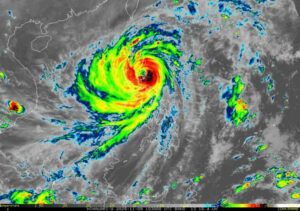By Vonn Andrei E. Villamiel
THE typhoons that struck in October and early November are expected to result in only minor disruptions to agriculture, analysts said.
“All sectors of Philippine agriculture will surely be affected by the series of typhoons and will have an impact on agriculture output. However, except for high-value crops, the typhoons are not expected to significantly affect overall output, and production for the year is likely to be better than in previous years,” Danilo V. Fausto, president of the Philippine Chamber of Agriculture and Food, Inc., told BusinessWorld via Viber.
Raul Q. Montemayor, national manager of the Federation of Free Farmers, said that while agriculture is still in “recovery mode” after a decline in 2024, recent storms are unlikely to derail growth.
“Typhoons are a normal occurrence in the fourth quarter. They will affect output, but not by much compared to levels in 2023, which was the last normal year,” he told BusinessWorld via Viber.
Mr. Montemayor said palay (unmilled rice) was largely at the harvest stage when the typhoons hit, so most losses were avoided. He added that while vegetables and other high-value crops could be affected, recovery times for such crops are generally short.
Poultry, which expanded 10.6% year on year in the third quarter, is also expected to sustain growth in the final quarter though, demand-side factors may temper expansion.
“There will be growth,” Elias Jose M. Inciong, chairman of the United Broiler Raisers Association, told BusinessWorld via Viber. “The main threat will be the demand side. If it’s weak compared to last year, the industry will adjust and reduce production. (Or) it may not expand substantially despite the normal boost provided by the holiday season,” he said.
Analysts are also not overly concerned about the fisheries sector, which recorded a year-on-year decline of 2.7% in the third quarter.
“Any storm negatively affects fisheries. But the sector is quick to recover. Right now, those with damaged fish cages and fishponds are preparing to repair, purchase what’s needed to restart, and keep producing,” Norberto Chingcuanco, co-convenor of Tugon Kabuhayan, told BusinessWorld via messenger.
Six storms have so far traversed the Philippines this quarter.
Typhoons Matmo (known in the Philippines as Paolo) and Fengshen (Ramil), which struck in October, caused combined agricultural losses valued at over P180 million, affecting 10,000 metric tons of crops, based on Department of Agriculture (DA) estimates.
Typhoon Matmo particularly affected rice and high-value crops in the Cagayan Valley, while Typhoon Fenshen affected rice, high-value crops, and poultry in Central Luzon, Calabarzon, Mimaropa, and the Western Visayas.
According to preliminary data from the DA Typhoon Kalmaegi (Tino), which recently crossed the Visayas and parts of Mindanao, inflicted P160 million in agricultural losses, affecting almost 6,000 farmers and about 3,500 hectares of farmland. The DA reported damage and losses in rice, corn, high-value crops, cassava, livestock, and poultry.
Damage to agriculture caused by Typhoon Fung-wong (Uwan), which recently crossed Luzon, have yet to be determined.






